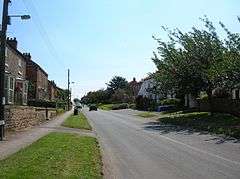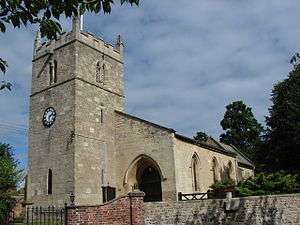Great Ouseburn
| Great Ouseburn | |
 Great Ouseburn, The Crown public house on the right |
|
 Great Ouseburn |
|
| OS grid reference | SE447617 |
|---|---|
| – London | 180 mi (290 km) SSE |
| Shire county | North Yorkshire |
| Region | Yorkshire and the Humber |
| Country | England |
| Sovereign state | United Kingdom |
| Postcode district | YO |
| Police | North Yorkshire |
| Fire | North Yorkshire |
| Ambulance | Yorkshire |
| EU Parliament | Yorkshire and the Humber |
Coordinates: 54°03′00″N 1°19′01″W / 54.050°N 1.317°W

Great Ouseburn is a village and civil parish in the Harrogate district of North Yorkshire, England. It is situated 4 miles (6 km) south-east of Boroughbridge. The village of Aldwark is to the north-east. It had a population of 598 according to the 2011 census.[1]
History
Great Ouseburn and Little Ouseburn both take their name from the river Ouse which begins in the garden of the Great Ouseburn Workhouse.[2] The original source of the Ouse (which is 35 metres away from where it flows now) is marked by a stone column reading "OUSE RIVER HEAD... OUSEGILL SPRING Ft. YORK 13miles BOROUGHBRIDGE 4miles".[3] The meadows by Ouse Gill Beck have since become a Site of Interest to Nature Conservation (SINC).[4]
Great Ouseburn was originally part of the district of Knaresborough, which was a royal forest in William the Conqueror’s time, giving Great Ouseburn the status of a "Forest Liberty Town"; it had the liberty to punish those people who misbehaved within its boundaries; in the Domesday survey the village is referred to as "Useburne".[5]
The estate, now known as Kirby Hall, was a major influence on the village and was owned by William de Kirkeby in 1200. The estate owned most of the village and the economy of Ouseburn was principally centred on the estate’s agricultural business. In 1912 most of the smallholdings were sold to the tenants.
Great Ouseburn was an administrative centre; during 1828 it was the headquarters of the Great Ouseburn Gilbert Union comprising 40 parishes. In 1854 it was replaced by the Great Ouseburn Poor Law Union. The Great Ouseburn Union workhouse building was built in 1856-7 and the infirmary was built in 1891.[6]
In 1854 Great Ouseburn Community Primary School was established with the laying of the foundation stone by Sir Henry Mesey-Thompson of Kirby Hall and the then Bishop of Ripon.[7]
In the 1870s, Great Ouseburn was described "as a village, a township, a parish, and a district, in W. R. Yorkshire...The township comprises 840 acres. Real property, £2, 781. Pop., 599. Houses, 123."[8]
An important aeroplane crash during the Second World War occurred in Great Ouseburn on the 30th of April, 1942. "De Havilland Flamingo R2764 of 24 Squadron crashed at Great Ouseburn in Yorkshire on 30 April 1942." The plane was carrying two Air Ministry Staff and four high ranking Russians. That morning the plane had travelled from RAF Hendon in London to RAF Tealing near Dundee. It was returning after a short stop at RAF East Fortune near Edinburgh when it developed engine trouble. The plane then caught fire and crashed to the ground in the field just behind Vine House. The Great Ouseburn Fire and Rescue where quickly on the scene, the fire was contained but there were no survivors.[9]
Governance
An electoral ward in the name of Ouseburn exists. This ward stretches south to Moor Monkton with at total population taken at the 2011 census of 3,675.[10]
Community
Great Ouseburn was designated a conservation area on 17 March 1994, the boundary roughly runs from the southern end of the village either side of Main Street up to the village Green.[11]
At present the village is mainly residential. Historic buildings include Rosehurst and Holly Cottage, and former farmhouses such as Church Hill Farm House and Prospect Farm House. Non-residential buildings in the village include the public house, the church, the post office, the school and the village hall. Walnut farm is the only remaining operational farm in the village. New modern residential development at the northern end of the village, such as the properties along the south side of Branton Lane are not characteristic of the locally distinctive properties of the historic buildings in the village.[12]
Annual events in the village include several Open Gardens days, a Village Hall craft fair, School Christmas fair, and a Spring Festival.[13]
Landmarks

In Great Ouseburn there are 15 buildings or structures that are included on the Statutory List of Buildings of Special Architectural or are of Historic Interest; Grade II*: St Mary’s Church; Grade II: The Churchyard walls & Cross, the Garden wall near Church Hill Farmhouse, Well Farm House, Walnut Farm House, Prospect Farm House, Church Hill Farm House, Church Hill Cottage, Yeomans Cottage, Wingate Cottage, Springfield Farm House, Holly Cottage; the house wall & railings, Manor House Garage, Cedar Croft and Rosecroft House & the wall & railings.[14]
St Mary’s Church is often argued to be the focal point of the village. The church has a Norman tower with a 13th century belfry, 14th century arcades, a 3-bay aisled nave rebuilt in 1820 and a 15th century chancel. The south chapel was constructed in 1883.[15]
Population
.jpg)
The graph shows that during the period of 1811 to 2011 census data has recorded fluctuations in the population of Great Ouseburn, starting at 395 in 1811 there was a gradual increase in population to 437 in 1821; the population then reached a peak in 1851 with 629 people; remaining in the 5th century for the 70 years the population the decreased to 368 in 1931 and then reached its lowest in 1951 at only 249 people increasing to 347 by 1961.[16] The census undertaken in April 2001 recorded the population of Great Ouseburn at 553 people, this number increased to 598 by the time of the 2011 census taken in March.[17]
Economy
Great Ouseburn's economy was mainly agricultural, but the village was also home to around thirty retail and manufacturing establishments in 1840.[18]

During 1950 there were 10 working farms in the village; now only Walnut Farm is left. The former brickyard, steam corn mill, tan yard and malt kilns of the 19th century have long since closed. With the introduction of the car, and mechanisation in agriculture, the post office shop, the Crown Inn, joinery workshop, stonemason, builder’s yard and blacksmith are the only trades and occupations that remain.[19]
The first census in 1801 only divided employment into three categories, those employed in agriculture and those employed in trade or manufacturing; the 1841 census was the first to gather detailed occupational data, although this was in no real order.[20][21]
The graph uses data from the 2011 census, it shows that wholesale and retail trade (59 people), professional, scientific and technical activities (37 people) and manufacturing (31 people) are the largest employers in the village.[22]
See also
![]() Media related to Great Ouseburn at Wikimedia Commons
Media related to Great Ouseburn at Wikimedia Commons
References
- ↑ "<Great Ouseburn> (Parish): Key Figures for 2011 Census: Key Statistics". Neighbourhood Statistics. Office for National Statistics. Retrieved 30 June 2014.
- ↑ "Welcome to the Great Ouseburn Parish Website". Great Ouseburn Parish Website. Retrieved 23 February 2013.
- ↑ "Great Ouseburn". Retrieved 16 March 2013.
- ↑ "Welcome to the Great Ouseburn Parish Website". Retrieved 20 March 2013.
- ↑ Gill, Jeff. "Great Ouseburn Parish Plan". Retrieved 1 April 2013.
- ↑ "Great Ouseburn Conservation Area Character Appraisal" (PDF). Harrogate Borough Council. Retrieved 27 March 2013.
- ↑ "GREAT OUSEBURN Conservation Area Character Appraisal" (PDF). Harrogate Borough Council. Retrieved 30 March 2013.
- ↑ Wilson, John (1870–72). "Imperial Gazetteer of England and Wales". Edinburgh: A. Fullarton and Co. Retrieved 4 February 2013.
- ↑ Cale, Kevin. "The Crash of De Havilland Flamingo R2764". The Flamingo Crash. Retrieved 18 March 2013.
- ↑ ")useburn ward population 2011". Retrieved 5 August 2015.
- ↑ Gill, Jeff. "Great Ouseburn Parish Plan". Retrieved 1 April 2013.
- ↑ "GREAT OUSEBURN Conservation Area Character Appraisal" (PDF). Harrogate Borough Council. Retrieved 29 March 2013.
- ↑ Gill, Jeff. "Great Ouseburn Parish Plan". Retrieved 1 April 2013.
- ↑ "GREAT OUSEBURN Conservation Area Character Appraisal" (PDF). Harrogate Borough Council. Retrieved 30 March 2013.
- ↑ "GREAT OUSEBURN Conservation Area Character Appraisal" (PDF). Harrogate Borough Council. Retrieved 30 March 2013.
- ↑ "Great Ouseburn". Vision Of Britain. Retrieved 18 March 2013.
- ↑ "Area: Great Ouseburn (Parish)". Office for National Statistics. Retrieved 18 March 2013.
- ↑ "GREAT OUSEBURN Conservation Area Character Appraisal" (PDF). Harrogate Borough Council. Retrieved 20 March 2013.
- ↑ "GREAT OUSEBURN Conservation Area Character Appraisal" (PDF). Harrogate Borough Council. Retrieved 20 March 2013.
- ↑ "Great Ouseburn AP/CP — Current theme: Social Structure". Vision Of Britain. Retrieved 20 April 2013.
- ↑ "Great Ouseburn AP/CP — Current theme: Social Structure". Vision Of Britain. Retrieved 20 April 2013.
- ↑ "Industry 2011". Office for National Statistics. Retrieved 22 April 2013.
External links
![]() Media related to Great Ouseburn at Wikimedia Commons
Media related to Great Ouseburn at Wikimedia Commons
| ||||||||||||||||||||||||||